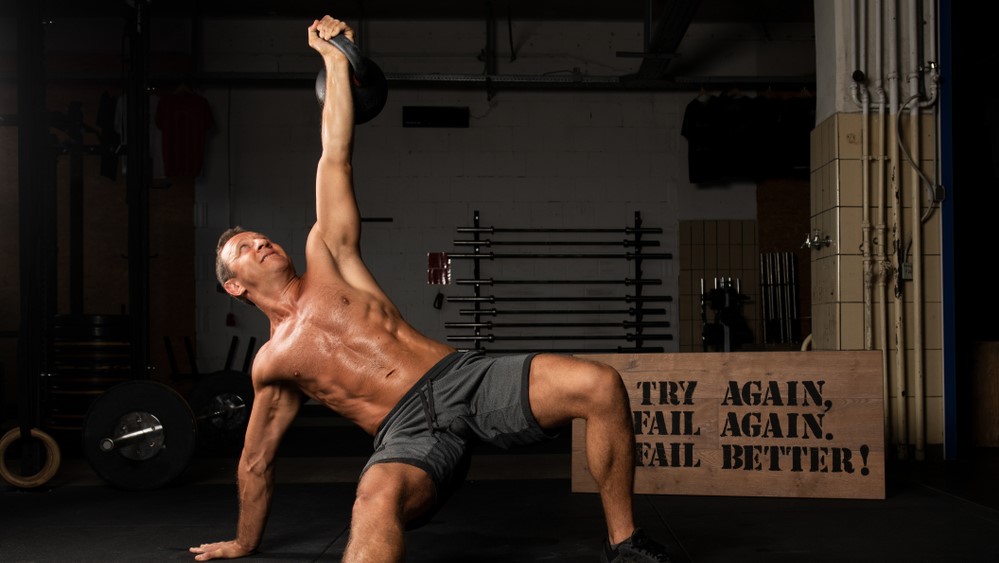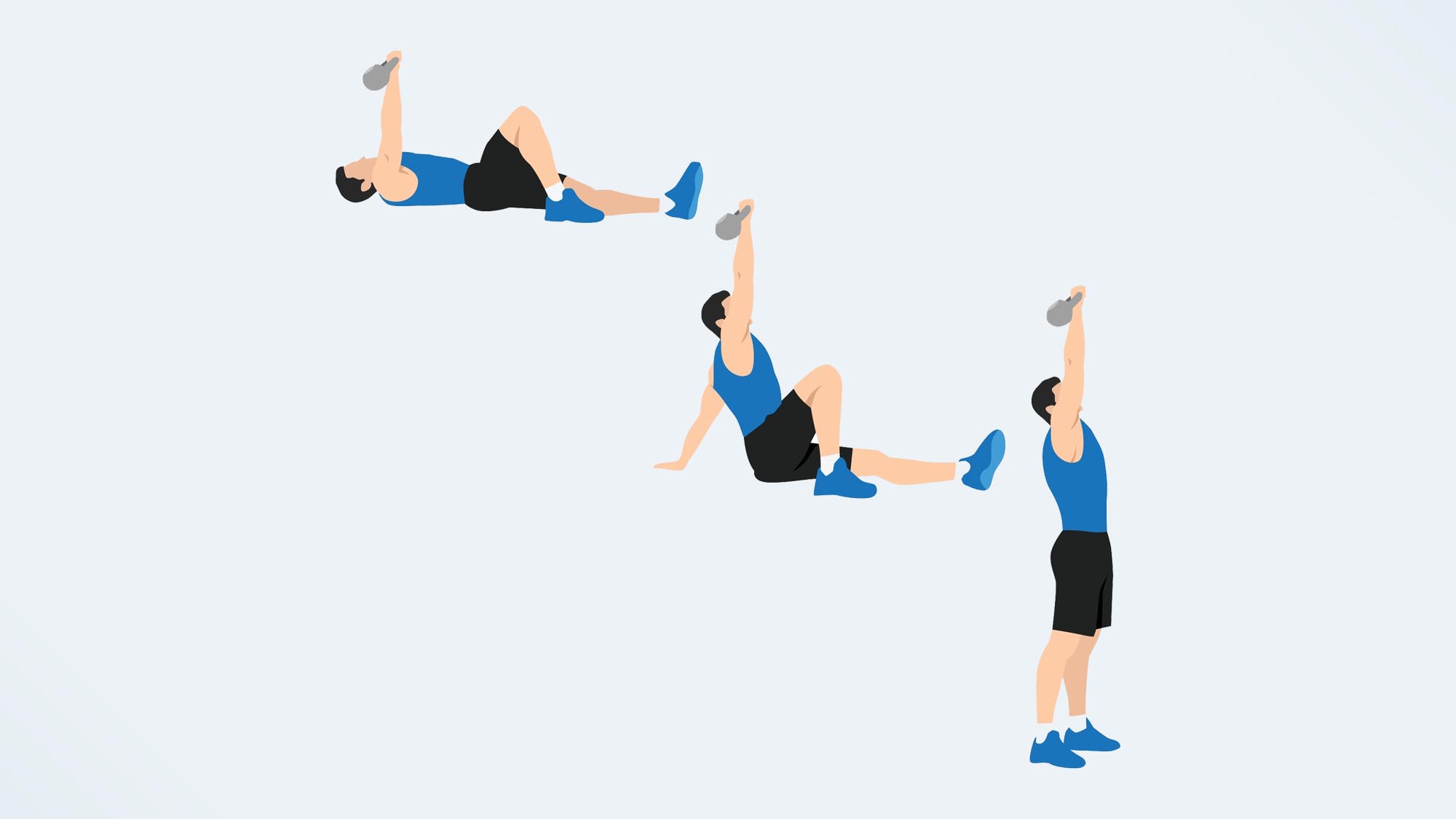This kettlebell exercise is a full-body workout — here’s how to do it

When it comes to finding the best kettlebell exercises to work your entire body, it doesn’t get much better than the Turkish get-up. This complicated kettlebell exercise takes you from lying, to standing, while holding a kettlebell over your head. It improves your coordination and works on your shoulder strength, while recruiting just about every muscle in your body.
Ready to get started? Here’s how to do a Turkish get-up, the benefits of the exercise and the variations to try.
As a reminder, if you’re completely new to this exercise, or you’re returning to exercise following an injury, it’s a good idea to check your form with a personal trainer before adding weight. If you’ve suffered from a shoulder injury, it’s also worth checking with your doctor before attempting Turkish get-ups. The right kettlebell weight for you will be challenging by the final few reps, without compromising your form — if in doubt, opt for a lighter weight until you are sure you are moving correctly. Lifting too heavy can put you at risk of an injury.
Looking for more kettlebell exercises to add to your routine? Here’s how to do a kettlebell swing, a 20-minute kettlebell workout that works your entire body, and what happened when our fitness writer did a 30-day kettlebell challenge.
How to do a Turkish get-up
A Turkish get-up is a compound exercise, as you work multiple muscle groups at the same time. Here’s how to do it:
1. Start by lying on your back, bend your right leg, and place your right foot flat on the floor. Straighten your left leg and your left arm, so that your arm is out to the side of your body, with your hand pressed into the floor. Straighten your right arm to the ceiling, holding the kettlebell. Don’t let your wrist bend, and keep your eyes focused on the kettlebell.
2. Push through your right heel and left elbow to raise your upper body up onto your left elbow.
Get instant access to breaking news, the hottest reviews, great deals and helpful tips.
3. Pressing into the floor using your left hand, engage your abs and raise your torso up into a seated position.
4. Slide your left leg underneath you and place your left knee on the floor. Your left hand, knee, and ankle should be in a straight line.
5. Shift your weight back in your heel to raise your body up so you are in a kneeling position, with your left knee on the floor and your torso straight.
6. Engage your core and push into your left foot so you are in a standing position, with your right arm straight and the kettlebell raised above your head.
7. You will now repeat all the steps above in reverse order to lower back down to your starting position. Step back into a reverse lunge position, lowering your knee to the ground, before sweeping your leg underneath you, so that you’re in the half-kneeling position.

What are the benefits of a Turkish get-up?
The Turkish get-up is named as such because it apparently has origins in the Turkish military. Either way, it’s a compound exercise that forces you to engage multiple muscle groups in the body. As well as your arms, legs, and core, the Turkish get-up forces you to engage those small stabilizing muscles which are important for weightlifting and running. If you’re going to focus on one kettlebell exercise, make it this one.
As you’re holding a kettlebell above your head for the entire movement, the Turkish get-up is fantastic if you’re looking to build strength in your shoulders. Practicing a Turkish get-up can help you lift heavier weights during your overhead presses and barbell lifts.
As well as your shoulders, you’ll work on your hip mobility and your core strength during this exercise. Spending time focusing on these little exercises can help reduce your chances of injury when weightlifting, as pretty much all lifts will require you to keep your torso rigid and your core engaged.
What are the form mistakes to look out for?
This exercise is definitely one you’ll need to practice in order to make it perfect. Here are a few common mistakes to look out for:
Rushing the exercise: The Turkish get-up is meant to be a slow, controlled movement. If you rush the exercise, you won’t get the same benefits, so if you find you’re moving as quickly as you would for kettlebell swings or kettlebell snatches, you need to slow down.
Not gripping the kettlebell correctly: If you’re unable to keep your arm outstretched throughout the movement, or you’re bending at the wrist, the chances are the kettlebell is too heavy. It’s always a good idea to practice this movement without any weight to master the form.
Not getting your hand placement right: If your hand isn’t in the right position, you’ll find it difficult to push up onto your forearm at the beginning of this move. Think about getting your hand at a 45-degree angle from your body, and focus on pushing it into the ground to create a stable base.
Rounding at the shoulders: Another common mistake is rounding at the shoulders during this exercise, which can make the whole move a little off balance. Think about keeping your shoulders back and your torso out and proud during the movement.
What are the best modifications to try?
If you’re completely new to the Turkish get-up, it’s a good idea to do the exercise without any weight until you feel comfortable and confident getting up and back down with your arm outstretched. If you find it hard to raise up onto your forearm, the chances are you need to work on your arm strength before attempting this move.
Once you’ve got the technique, the Turkish get-up can be made more difficult by increasing the weight of the kettlebell in your hand.
Next up: why not learn how to bench press?

Jane McGuire is Tom's Guide's Fitness editor, which means she looks after everything fitness related - from running gear to yoga mats. An avid runner, Jane has tested and reviewed fitness products for the past five years, so knows what to look for when finding a good running watch or a pair of shorts with pockets big enough for your smartphone. When she's not pounding the pavements, you'll find Jane striding round the Surrey Hills, taking far too many photos of her puppy.
